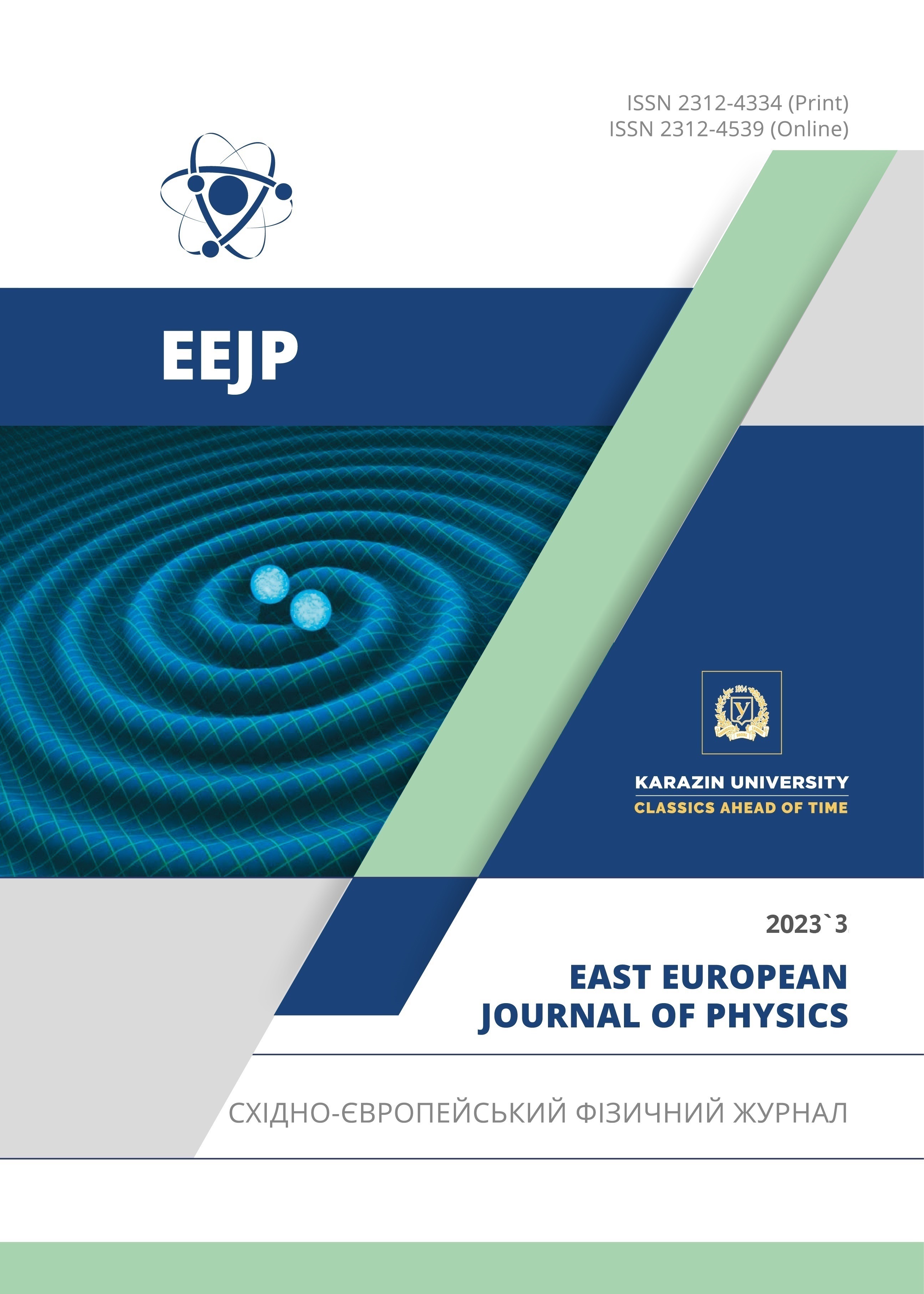Дослідження ядерного потенціалу з використанням розрахунку квазіпружного розсіювання для реакцій 9,10,11Be+208Pb
Анотація
Конкретні систематичні дослідження параметра ядерного потенціалу для реакцій важких іонів, які включають системи, були досягнуті за допомогою великокутового квазіпружного розсіювання при глибоких підбар’єрних енергіях, близьких до висоти кулонівського бар’єру. Для визначення ядерного потенціалу були проведені розрахунки для одноканального (SC) варіанту та варіанту зв’язаних каналів (CC). Метод хі-квадрат χ2 використовувався для визначення найкращого значення ядерного потенціалу порівняно з експериментальними даними. Найкращі значення ядерного потенціалу знайдено з розрахунків зв’язаних каналів для інертного снаряда та коливальної мішені для систем: 9Be+208Pb, 10Be+208Pb, 11Be+208Pb, які дорівнюють 45 МеВ, 65 МеВ, 53 МеВ відповідно.
Завантаження
Посилання
R. Naik, PhD Thesis, “Studying fusion reactions for effect of P (CN) on heavy nucleus formation and for nuclear structure effects,” Oregon State University, 2007.
Hayef, Nagham H and Jassim, Khalid S.Coupled channels for quasi-elastic scattering of determining diffuseness parameters in Woods-Saxon potential for nuclear reaction. AIP Publishing LLC2023.
Z.M. Cinan, B. Erol, T. Baskan, and A.H. Yilmaz, “Heavy-Ion Fusion Reaction Calculations: Establishing the Theoretical Frameworks for 111” In Radionuclide over the Coupled Channel Model,” Energies, 14(24), 8594 (2021). https://doi.org/10.3390/en14248594
F.A. Majeed, K.S. Jassim, and N.H. Abbas, “Role of Coupled-Channels in Heavy Ions Reactions at the Coulomb Barrier,” Int. J. Sci. Res. 3, 315-319 (2014). https://livedna.net/?dna=964.25272
H. Timmers, J.R. Leigh, M. Dasgupta, D.J. Hinde, R.C. Lemmon, J.C. Mein, C.R. Morton, et al., “Probing fusion barrier distributions with quasi-elastic scattering,” Nuclear Physics A, 584(1), 190-204 (1995). https://doi.org/10.1016/0375-9474(94)00521-N
K.S. Jassim, and Q.J. Tarbool, “A Study of the surface diffuseness of inter-nucleus potential with quasi-elastic scattering for the 32,34
S+208 82Pb reactions,” Al-Bahir Journal for Engineering and Pure Sciences, 1(1-2), 125-140 (2015). https://www.iasj.net/iasj/pdf/a338dda2a3e54bda
H[7] K. Hagino, and N. Rowley, “Large-angle scattering and quasielastic barrier distributions,” Phys. Rev. C, 69, 054610 (2004). https://doi.org/10.1103/PhysRevC.69.054610
M. M.Evers, Ph.D thesis, “Systematics of near-barrier nuclear reactions using quasi-elastic scattering”, The Australian National University (2010).
Q.J. Tarbool, K.S. Jassim, and A.A. Abojassim, ”Surface diffuseness parameter with quasi-elastic scattering for some heavy-ion systems,” International Journal of Nuclear Energy Science and Technology, 13(2), 2019. https://www.inderscienceonline.com/doi/pdf/10.1504/IJNEST.2019.100758
N. Wang, and M. Liu, and Y.-X. Yang, “Heavy-ion fusion and scat- tering with Skyrme energy density functional,” Sci. China Series G: Physics, Mechanics and Astronomy, 2009.Sci. China Ser. G-Phys. Mech. Astron. f52, 1554–1573 (2009). https://doi.org/10.1007/s11433-009-0205-z
V.I. Zagrebaev, ”Understanding the barrier distribution function derived from backward-angle quasi-elastic scattering,” Phys. Rev. C, 78, 047602 (2008), https://doi.org/10.1103/PhysRevC.78.047602
M. Zadro, P. Figuera, A. Di Pietro, M. Fisichella, M. Lattuada, T. L¨onnroth, M. Milin, et al., ”Quasielastic backscattering and barrier distributions for the 6, 7 Li+ 64 Zn systems,” Physical Review C, 87 054606 (2013).
https://doi.org/10.1103/PhysRevC.87.054606
P.R.S. Gomes, D.R. Otomar, T. Correa, L.F. Canto, J. Lubian, R. Linares, D.H. Luong, et al., ”Complete fusion enhancement and suppression of weakly bound nuclei at near barrier energies,” J. Phys. G: Nucl. Part. Phys. 39 115103 (2012). https://doi.org/10.1088/0954-3899/39/11/115103
Y.Y. Yang, J.S. Wang, Q. Wang, D.Y. Pang, J.B. Ma, M.R. Huang, P. Ma, et al., ”Quasi-elastic scattering of 10,11C and 10B from a natPb target,” Phys. Rev. C, 90, 014606 (2014). https://doi.org/10.1103/PhysRevC.90.014606
K. Hagino, N. Rowley, and A.T. Kruppa, ”A program for coupled-channel calculations with all order couplings for heavy-ion fusion reactions,” Computer Physics Communications, 123(1-3), 143-152 (1999). https://doi.org/10.1016/S0010-4655(99)00243-X
M. Dasgupta, D.J. Hinde, J.O. Newton, and K. Hagino, ”The nuclear potential in heavy-ion fusion,” Progress of Theoretical Physics Supplement, 154, 209–216 (2004). https://doi.org/10.1143/PTPS.154.209
L.R. Gasques, M. Evers, D.J. Hinde, M. Dasgupta, P.R.S. Gomes, R.M. Anjos, M.L. Brown, et al., ”Systematic study of the nuclear potential through high precision back-angle quasi-elastic scattering measurements,” Phys. Rev. C, 76, 024612 (2007). https://doi.org/10.1103/PhysRevC.76.024612
M.V. Andres, N. Rowley, and M.A. Nagarajan, ”Effect of deformation on the elastic and quasielastic scattering of heavy ions near the Coulomb barrier,” Physics Letters B, 202(3), 292-295 (1988). https://doi.org/10.1016/0370-2693(88)90473-X
W. Reisdorf, ”Heavy-ion reactions close to the Coulomb barrier,” J. Phys. G: Nucl. Part. Phys. 20, 1297 (1994). https://doi.org/10.1088/0954-3899/20/9/004
K. Washiyama, K. Hagino, and M. Dasgupta, ”Probing surface diffuseness of nucleus-nucleus potential with quasielastic scattering at deep sub-barrier energies,” Phys. Rev. C, 73, 034607 (2006). https://doi.org/10.1103/PhysRevC.73.034607
RIBLL Collaboration, ”Scattering of the halo nucleus 11Be from a lead target at 3.5 times the Coulomb barrier energy,” Physics Letters B, 811, 135942 (2020). https://doi.org/10.1016/j.physletb.2020.135942
Авторське право (c) 2023 Алі А. Рахіз, Халід С. Джассім

Цю роботу ліцензовано за Міжнародня ліцензія Creative Commons Attribution 4.0.
Автори, які публікуються у цьому журналі, погоджуються з наступними умовами:
- Автори залишають за собою право на авторство своєї роботи та передають журналу право першої публікації цієї роботи на умовах ліцензії Creative Commons Attribution License, котра дозволяє іншим особам вільно розповсюджувати опубліковану роботу з обов'язковим посиланням на авторів оригінальної роботи та першу публікацію роботи у цьому журналі.
- Автори мають право укладати самостійні додаткові угоди щодо неексклюзивного розповсюдження роботи у тому вигляді, в якому вона була опублікована цим журналом (наприклад, розміщувати роботу в електронному сховищі установи або публікувати у складі монографії), за умови збереження посилання на першу публікацію роботи у цьому журналі.
- Політика журналу дозволяє і заохочує розміщення авторами в мережі Інтернет (наприклад, у сховищах установ або на особистих веб-сайтах) рукопису роботи, як до подання цього рукопису до редакції, так і під час його редакційного опрацювання, оскільки це сприяє виникненню продуктивної наукової дискусії та позитивно позначається на оперативності та динаміці цитування опублікованої роботи (див. The Effect of Open Access).








